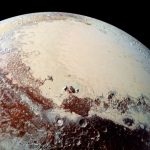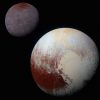50 years ago, astronomers were chipping away at Pluto’s mass0
- From Around the Web, Space
- September 2, 2021
Excerpt from the August 28, 1971 issue of Science News

Excerpt from the August 28, 1971 issue of Science News

Pluto may be a more habitable world than scientists had thought.

New research hints that liquid water might be common at the solar system’s edge

A “beating heart” of frozen nitrogen controls Pluto’s winds and may give rise to features on its surface, according to a new study.

One famous astrophysicist has said Pluto is his “favourite comet.”

The dwarf planet has short-lived ammonia on its icy surface

The tenuous nitrogen atmosphere of the dwarf planet Pluto is predicted to ultimately collapse and freeze over.

Collisions between bodies in our Solar System produce impact craters on large objects at a rate that depends on the population of impacting small bodies. By mapping the scars of ancient impacts on the surfaces of Pluto and its moon Charon, planetary researchers have discovered a surprising lack of very small objects (from 300 feet to 1 mile, or 91 m to 1.6 km, in diameter) in the Kuiper Belt.

The reason Pluto lost its planet status is not valid, according to new research from the University of Central Florida in Orlando.

NASA’s New Horizons team has released the first official global mosaic and topographic maps of the dwarf planet Pluto and its largest moon, Charon.



